When Do Dalmatians Go into Heat?
Dalmatians, known for their distinct black-and-white spots and energetic personalities, are a stunning and intelligent breed. Pet owners may wonder when Dalmatians typically go into heat and what signs to expect during that time. Understanding a dog’s heat cycle, especially for a breed like Dalmatians, is essential for responsible pet parenting and reduces the chances of unplanned breeding.
A Dalmatian female’s first heat usually occurs between the ages of 6 to 12 months and is commonly accompanied by physical and behavior changes. The heat cycle lasts about three weeks, with the most fertile period happening around the second week. It’s important to monitor your Dalmatian closely during this time, as her newfound flirtations with fellow dogs could result in an unplanned litter of spotty puppies.
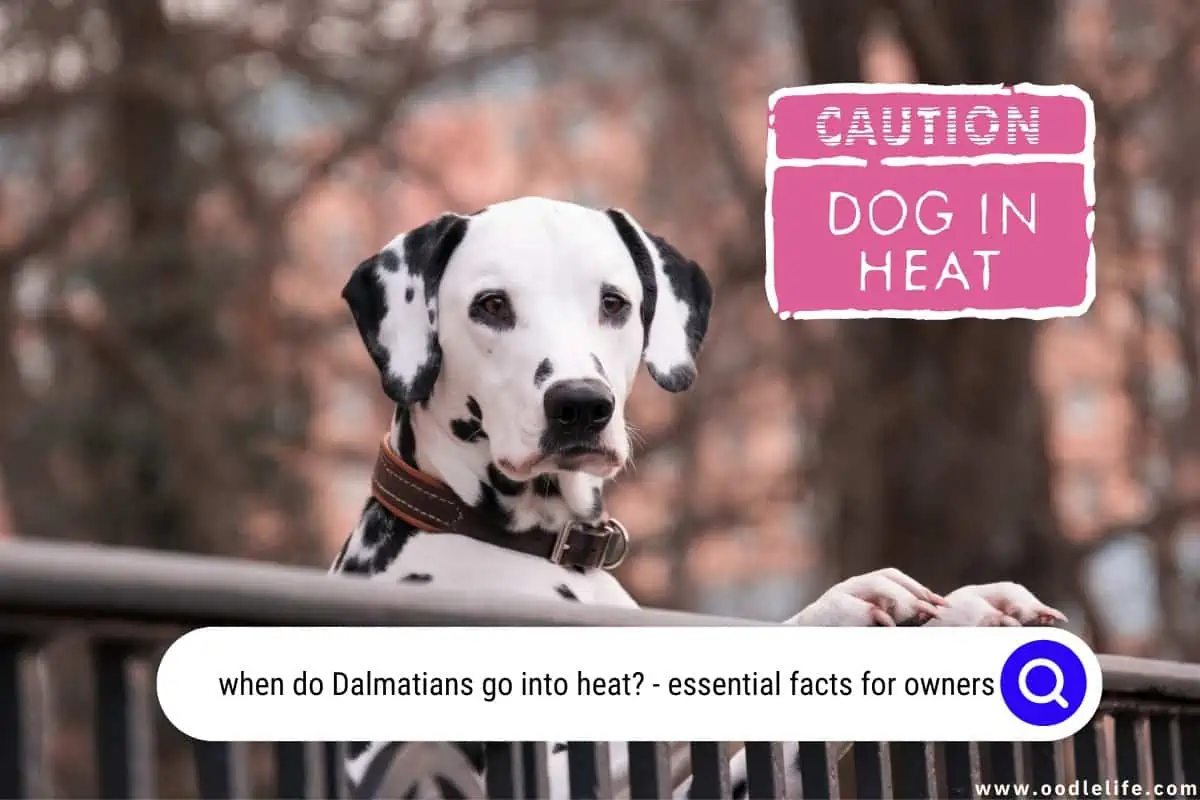
Keep an eye out for signs of your Dalmatian going into heat, such as a swollen vulva, light blood discharge, and increased urination. She might become slightly moodier, or she may seem extra affectionate – each dog has her own unique response to the hormonal shifts. Similar to a human craving chocolate during that time of the month, your Dalmatian may also show a sudden interest in digging holes in the yard to seek buried “treasures.”
Be patient, observant, and keep her on a leash during walks to ensure her safety and that of other dogs in the neighborhood.
Understanding Dalmatians’ Heat Cycles
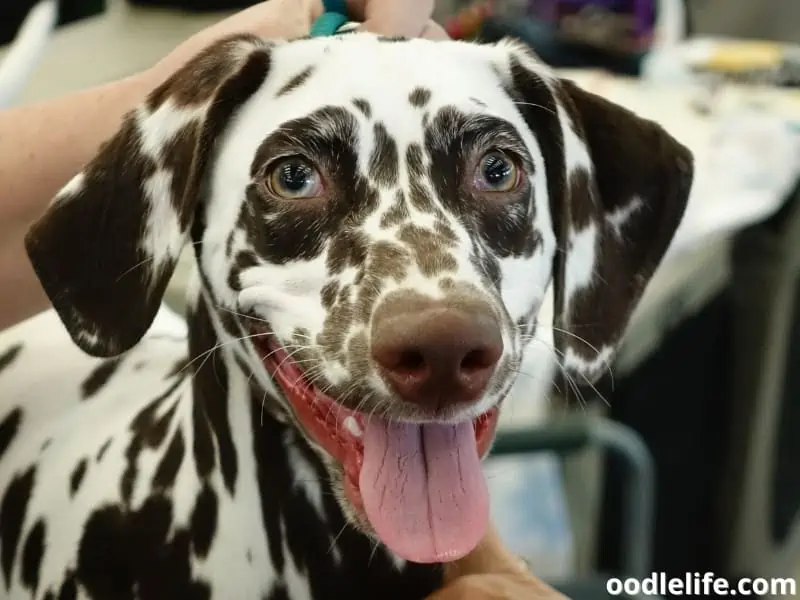
Frequency
Dalmatian females typically experience their first heat cycle between 6 and 18 months of age. Like other dog breeds, they go into heat approximately every 6 months thereafter. When determining the exact timing, it’s essential to carefully observe your Dalmatian’s behavior and physical changes.
Duration
A Dalmatian’s heat cycle generally lasts about 3 weeks. It can be divided into three main phases:
- Proestrus (Appetizers, anyone?): This phase lasts around 7 to 10 days. During this time, your Dalmatian will show increased interest in male dogs. Her vulva may swell, and she’ll have a bloody discharge. Think of it as the pre-game party before the actual event.
- Estrus (The main event): Welcome to the most fertile phase of the cycle! Estrus lasts about 5 to 9 days and is characterized by a change in the color and consistency of the discharge, as well as increased friendliness towards male dogs. Your Dalmatian’s tail may also exhibit a curve known as “flagging,” making it look like she’s trying to strike up a conversation with potential suitors.
- Diestrus (Time to wind down): Lasting for around two weeks, this phase marks the end of your Dalmatian’s cycle. During diestrus, her discharge will become less frequent and her interest in male dogs will fade.
In summary, understanding your Dalmatian’s heat cycle comes down to observing her behavior and physical changes. Regular interaction and keen observation will help you determine the frequency and duration of her heat cycles, ensuring that you can provide the best care for your four-legged friend.
Signs of A Dalmatian in Heat
Behavioral Changes
Dalmatians, like other dog breeds, display certain behavioral changes when they go into heat. For instance, you might notice your Dalmatian’s sudden interest in other dogs, especially males. This is due to hormonal shifts that influence their behavior during this time.
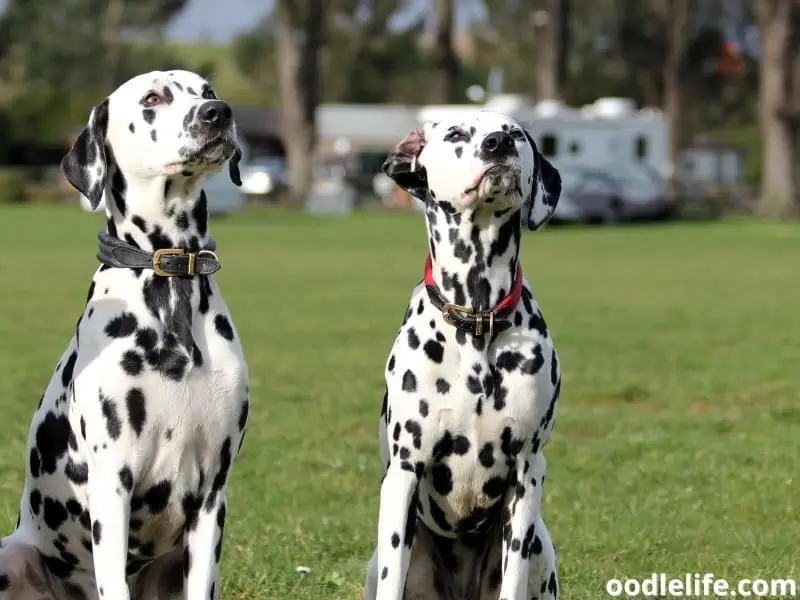
Another common sign is increased restlessness or agitation, as your pup may become more sensitive and easily irritated.
Playing with words, if your typically well-behaved Dalmatian starts acting like a “hot mess,” they might actually be in heat!
Physical Changes
In addition to behavioral shifts, Dalmatians also experience noticeable physical changes during their heat cycle. One of the most telltale signs is swelling of the vulva. This can be easily observed during your regular grooming sessions or when your Dalmatian is lying down.
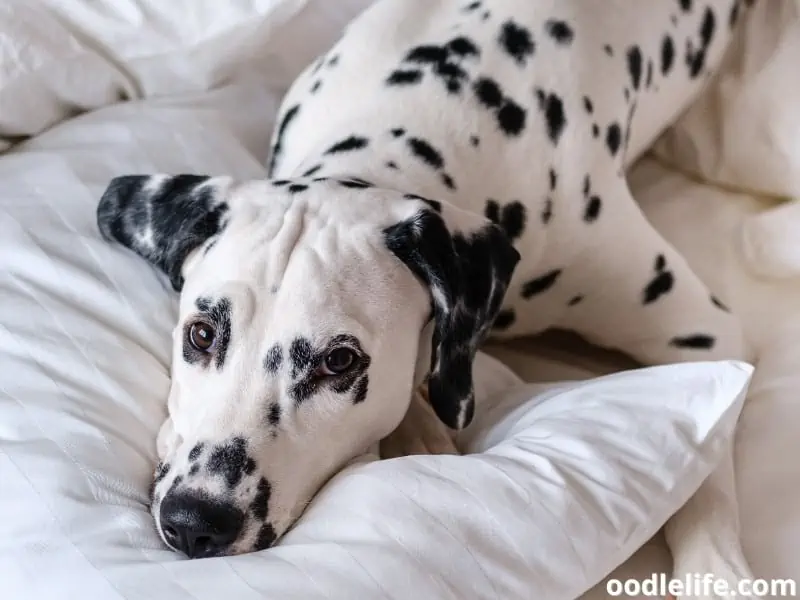
You may also notice some bloody discharge, which is a normal part of the heat cycle. Don’t worry, you’re not dealing with a crime scene – it’s just nature doing its thing!
To sum it up, when your Dalmatian goes into heat, keep an eye out for sudden behavioral and physical changes. Armed with this knowledge, you’ll be better prepared to support your furry friend during this sensitive time. Remember, it’s just a phase and, like a dramatic teenage movie, this too shall pass.
Preparing for Your Dalmatian’s Heat
As a responsible Dalmatian owner, it’s essential to be well-prepared for your dog’s heat cycle. In this section, we will discuss ways to ensure proper hygiene and care, as well as measures to ensure safety and containment.
Hygiene and Care
During your Dalmatian’s heat, cleanliness is key.
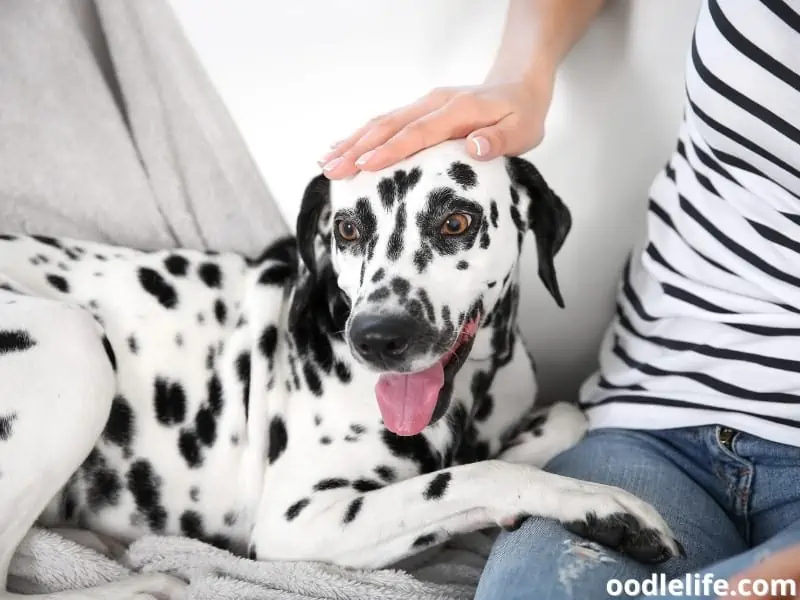
Make sure you have the following items on hand to maintain your dog’s hygiene:
- Dog diapers: Disposable or washable pet diapers can help contain messes and keep your home and furniture clean.
- Dog-safe cleaning supplies: Accidents happen; be prepared with pet-friendly cleaning products to remove stains and odors.
- Regular grooming: Brush your Dalmatian daily to keep her coat clean and free from debris. A clean coat will make it easier to spot any potential issues, such as excessive licking.
It’s important to monitor your Dalmatian’s health during this time. Check for any signs of discomfort, such as swelling, redness, or discharge. If you notice any issues, consult your veterinarian for guidance.
Safety and Containment
Ensuring your Dalmatian’s safety is crucial during her heat cycle.
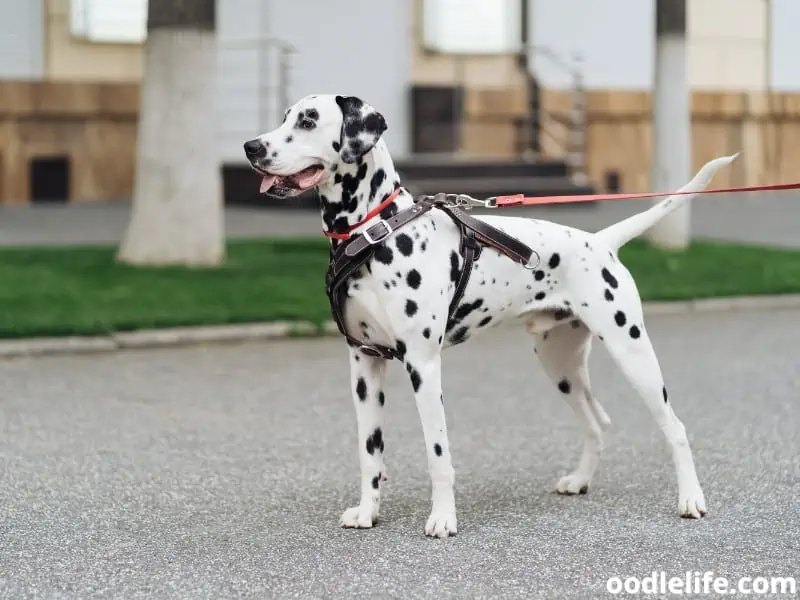
Here are a few tips to keep your dog secure and contained:
- Leashed walks: When taking your Dalmatian outside, use a secure leash and harness. Dogs in heat can be more prey-driven and prone to wandering. Keeping your dog on a leash can help prevent accidents.
- Supervision: Always supervise your Dalmatian when she is outdoors, even in a fenced yard, as other animals may be attracted to her scent.
- Separation from other dogs: If you have other dogs at home, keep them separate from your Dalmatian during her heat cycle. This will prevent unplanned pregnancies and reduce the risk of any aggression-related incidents.
Remember, remaining attentive and proactive during your Dalmatian’s heat cycle will help ensure her wellbeing and keep your environment clean and safe.
The Breeding Process
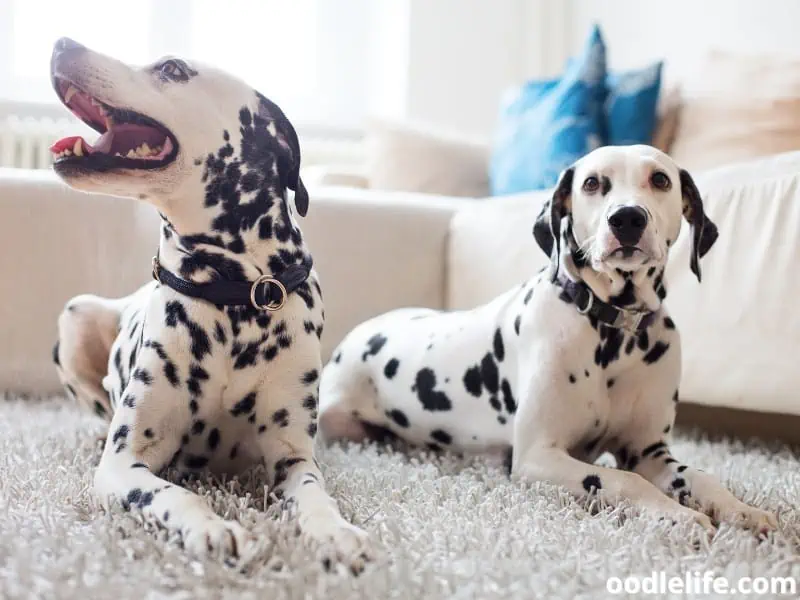
Optimal Time for Mating
Dalmatians, like most dog breeds, typically go into heat twice a year, with each heat cycle lasting around 21 days. The optimal time for mating is during the estrus phase of the heat cycle, which occurs about 9-14 days into the cycle. During this time, the female Dalmatian is most receptive to mating and has the highest chance of successful fertilization.
One way to determine the best time for mating is by monitoring the female Dalmatian’s behavior and distinctive signs like vaginal discharge, swelling, and “flagging” her tail when approached by a male. It could also be helpful to consult with a veterinarian who can perform hormonal tests to accurately pinpoint the most fertile time frame.
Potential Risks and Complications
Breeding dogs, including Dalmatians, can come with some potential risks and complications that breeders should be aware of. Some of these include:
- Genetic issues: Dalmatians are prone to certain genetic health problems, such as deafness and urinary tract issues. Responsible breeders should screen potential mating pairs for these conditions to minimize passing them on to the offspring.
- Infections: Female Dalmatians can be susceptible to infections during their heat cycle, such as pyometra (pus-filled uterus), which can be life-threatening if not treated promptly. Maintaining hygiene during the mating process is essential to avoid complications.
- Difficulty in mating or conception: If either the male or female Dalmatian is inexperienced or has health issues, the mating process may be unsuccessful or complicated.
Tips to Ensure a Smooth Breeding Process
To provide the best chances of successful breeding, keep these tips in mind:
- Choose healthy, well-matched Dalmatian pairs for mating.
- Monitor the female Dalmatian’s heat cycle closely to determine the optimal time for mating.
- Keep both the male and female Dalmatian in a calm, comfortable environment during the breeding process.
- Consult with a veterinarian for guidance and screening of potential health issues.
With careful planning and attention to detail, the breeding process for Dalmatians can result in a litter of healthy, adorable pups.
When to Consult a Veterinarian
Dalmatians, like all dog breeds, go into heat periodically. It’s essential to know when to consult a veterinarian to ensure the well-being of your furry friend.
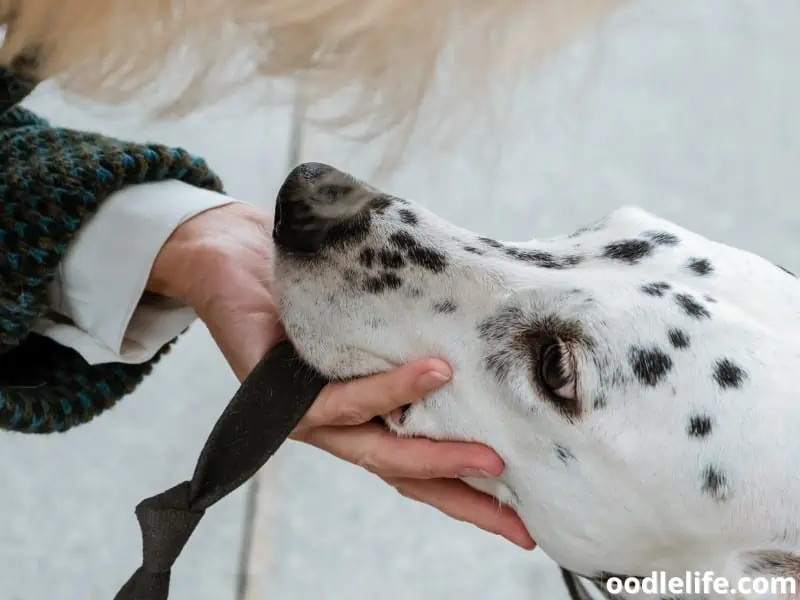
Signs of Complications
While most heat cycles occur without any hiccups, complications can arise. Keep an eye out for these signs, and consult your veterinarian if you notice any of the following:
- Discharge with a foul smell: A strong odor could indicate an infection that requires medical attention.
- Excessive bleeding or prolonged heat cycle: If your Dalmatian’s heat cycle lasts longer than three weeks or involves heavy bleeding, consult your vet.
- Lethargy or loss of appetite: These symptoms may signal an underlying health issue that requires a vet’s attention.
- Signs of pain or discomfort: Your Dalmatian should not experience significant pain during their heat cycle. If they appear to be in pain, it’s worth a trip to the veterinarian.
Post-Heat Checkup
It’s always a good idea to bring your Dalmatian to the veterinarian for a checkup after their heat cycle. Some reasons to schedule a post-heat appointment include:
- Monitoring overall health: Regular checkups allow your vet to keep tabs on your Dalmatian’s general health and address any concerns promptly.
- Pregnancy concerns: If your Dalmatian was not properly separated from male dogs during her heat cycle, an unexpected pregnancy may occur. Your vet can help confirm or rule out pregnancy and provide guidance on next steps.
- General care advice: Your veterinarian can offer tips for managing your Dalmatian’s heat cycle more comfortably, such as suggesting dietary adjustments or recommending mild forms of exercise.
Remember, as a responsible Dalmatian owner, it’s best to remain vigilant during your dog’s heat cycle and consult a veterinarian if any concerns arise. Your beloved four-legged friend will appreciate the extra care and attention.
Conclusion
Dalmatians, like other breeds of dogs, go into heat periodically and understanding this cycle can help dog owners better care for their pets. Females typically experience their first heat cycle between 6 and 9 months of age, and then approximately every six months thereafter. The heat cycle lasts for about 3 weeks, but can vary slightly depending on the individual dog.
During this time, pet owners should be extra vigilant about monitoring their Dalmatians, paying close attention to behavioral changes and physical signs. Some of the signs that a Dalmatian is in heat include swelling of the vulva, blood-tinged discharge, increased urination, and more frequent licking of the genital area. It’s also not uncommon for the dog’s temperament to change during this time, becoming either more affectionate or more irritable.
In order to ensure the safety and well-being of your Dalmatian and avoid unwanted pregnancies, it’s important to keep her separated from intact male dogs during the heat cycle. This can be done by keeping your dog indoors or using a secure, fenced area outdoors. It’s also a good idea to avoid taking your Dalmatian to places where other dogs may be present, such as dog parks or popular walking trails.
In conclusion, understanding your Dalmatian’s heat cycle can help you anticipate her needs and minimize any stress or discomfort she may be experiencing. By staying informed and vigilant, you can maintain a healthy and safe environment for your beloved furry friend. And remember, a little extra love and attention during this time can go a long way in keeping your Dalmatian happy and comfortable.